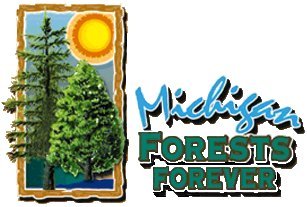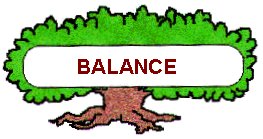

Home Page |
MICHIGAN FORESTS FOREVER TEACHERS GUIDE
| A PRIMER ON FORESTRY |  |
What is Forestry?
| Definition -
FORESTRY: The profession embracing the science, art, and practice of
creating, managing, using, and conserving forests and associated resources for human
benefit and in a sustainable manner to meet desired goals, needs, and values --
note: the broad field of forestry consists of those biological, quantitative,
managerial, and social sciences that are applied to forest management and conservation; it
includes specialized fields such as agroforestry, non-industrial forestry, and wilderness
and recreation forestry. -Society of American Foresters, 1998 |
Trees and forests are the primary foci of forestry. Science, research, and experience have taught forestry a lot about trees. For the most part, we know how they grow, how to enhance tree health and growth, and we know much about their habitat requirements and life cycles.
Forestry also knows a great deal about forests, which encompass many more components than just trees. Nevertheless, forestry probably knows less about forests and forest ecology, than characteristics of individual tree species.
A managed forest is an attempt to produce a set of outputs, whatever those might be for a particular ownership at a particular time. See the Multiple Use section for a discussion on this. The actual set of practices prescribed for a stand of trees is called silviculture. "Silvi" refers to trees and "culture" refers to management. Note how the terms "forestry" and "silviculture" are related.
There are seven (at least) objectives when implementing silvicultural practices.
| Definition -
SILVICULTURE: The art and science of controlling the establishment,
growth, composition, health, and quality of forests and woodlands, to meet the diverse
needs and values of landowners and society on a sustainable basis. -Society of American Foresters, 1998 |
What are Some Examples of Forestry?
Several groups of silvicultural practices can be identified. Arguably, the most familiar practices involve timber harvest. Under management, timber harvest is part of a silvicultural system designed to both harvest and regenerate forests in a sustainable manner. Timber harvest without silvicultural considerations can damage both the forest stand and the site itself. However, the difference between the two may not be readily apparent. The most commonly used management systems in Michigan are clearcut, shelterwood, and selection systems. These are described and discussed on the management systems page.
The harvest or cutting of trees sometimes may not involve a regeneration component but would still be considered good forestry. Thinning is often done to improve the quality of trees in a stand or promote greater stand health. A good example would be in a red pine plantation where stand densities have reached levels that impede the growth of trees. A thinning would be prescribed that reduces stand density, allowing the remaining trees to maintain healthy growth rates. The impact on regeneration would be negligible. Thinning may also be employed to reduce fuel loads in order to reduce fire hazard; or it might be used to harvest short-lived species in stand where long-lived species are preferred (e.g. sugar maple and northern white-cedar).
Release cutting is designed to remove larger, older overhead trees to provide more light to smaller, younger trees in the understory. White pine and northern red oak are species that can benefit from overhead release. Salvage cutting involves response to natural catastrophes created by windstorms, wildfire, or insect and disease outbreaks. It attempts to utilize as much of the wood resource as possible and promote the regeneration of the next forest. Pruning of pine or other species removes lower branches that would otherwise create log defects in future growth. Lower branches typically do not contribute much to a tree's photosynthetic capacity and sometimes are actually a drain on a tree's resources.
Planting trees is another very familiar aspect of forestry and forest management that entails a great deal more than simply putting seedlings in the ground. In most situations, a planting area has aspects quite hostile to young trees. Grasses and shrubs present significant competition for light, water, and nutrients. Properly preparing a site and following through with appropriate post-planting practices are essential to a successful planting operation. Many times it takes a planting failure for people to appreciate the role of site preparation and tree tending. Link to these pages for more information about tree planting and tree plantations.
Genetic improvement is an aspect of forestry that is not often considered. Some tree species possess a wide range of genetic variability, such as quaking aspen (genus Populus). Other species, such as red pine, display relatively little genetic variation across its range. Tree species can be bred, using traditional techniques, to produce strains that display desired characteristics. These trees are grown in "seed orchards" where their seed is regularly collected and distributed. Trees may be "improved" to enhance their form (timber quality), foliage appearance (Christmas and ornamental trees), growth rate (fiber production), resistance to disease (Dutch elm or white pine blister rust), and other features. Tree nurseries, whether for genetic improvement or stock production require specialized knowledge and practices.
Forest and tree health concerns sometimes prompt the cutting of trees or other practices. Reducing the beech component in beech-heavy stands will minimize the impact of the beech bark disease in Michigan. Harvesting balsam fir stands before they become overmature can depress and minimize epidemics of spruce budworm. Creating a patchwork of size classes and ages in a jack pine glacial outwash plain will lessen the chances of a catastrophic wildfire. A similar patchwork in an aspen-dominated area will maximize habitat for wildlife species such as ruffed grouse (partridge), woodcock, and white-tailed deer. Harvesting may be curtailed or eliminated along watercourses and in other circumstances made special due to a rare ecological feature, landform, archeology, visual sensitivity, and for other reasons.
For a more complete review of Michigan Forestry, go to the Forest Management Guidelines For Michigan, published by the Michigan Society of American Foresters.
Careers In Forestry
A forester usually carries at least a Bachelor's degree from an accredited university. Foresters might also have Masters or Doctoral degrees. Forestry curricula are heavy to the sciences, math, and technology. Writing and communication are increasingly being emphasized.
Forestry has many aspects and specialties, not unlike other professions. Timber management and fire suppression might first come to mind for many people. But that is only part of forestry. Some of the other aspects include entomology (insects), pathology (diseases), geographic information systems, forest inventory, social aspects of forestry, agroforestry, urban forestry (arboriculture), education, landscape & watershed management, wildlife & habitat, forest management planning, tree nursery science, soils, forest genetics, forest research, economics, recreation, policy creation / advisement, tax law, and many others. The Society of American Foresters recognizes over 700 job categories among its members.
There are also many employers. The most commonly thought of employers are likely to be the Michigan DNR and the U.S. Forest Service. However, there are many public, private, and non-profit agencies that employ foresters, from a major forest products company to the IRS. Michigan has about 600-700 foresters, but that is a very rough estimate.
There are two Michigan universities with undergraduate
degree programs in forestry.
Michigan State University (East Lansing)
Michigan Technological University (Houghton)
Other Midwest accredited forestry schools are:
| University
of Wisconsin-Stevens Point University of Wisconsin-Madison University of Minnesota (St. Paul) Purdue University (West Lafayette, Indiana) |
Southern Illinois University
(Carbondale) Iowa State University (Ames) Ohio State University (Columbus) |
 |
Activity Suggestion PLT Forest Consequences PLT Forest for the Trees |
 |
This website was developed and created by Michigan State University Extension for the teachers of the State of Michigan. |
Page Name: Primer.htm